Wetland Mystery
Air Date: Week of July 13, 2007
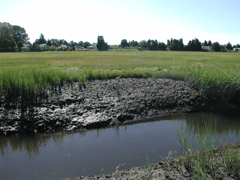
An area exhibiting dieback at the Hammonasset State Park wetland in Connecticut. (Photo: Wade Elmer)
Marsh grass is dying in wetlands in the northeastern U.S. Scientists are having a hard time finding out what’s causing this “sudden wetland dieback.” Living on Earth’s Ashley Ahearn visited some sick wetlands and has our story.
Transcript
CURWOOD: It’s Living on Earth. I’m Steve Curwood. Coastal wetlands help filter water and provide some of nature’s best protection from storms. But in parts of the Northeast coast of the U.S., something murky is going on in wetland salt marshes and scientists are perplexed. Once healthy green marsh grasses are now mottled with patches of brown stalks. Researchers call it Sudden Wetland Dieback and it’s happening from Maine to New York. Living on Earth’s Ashley Ahearn went to the wetlands to investigate.
[MARSH BIRDS/WATER GURGLING]
AHEARN: The Wellfleet Salt marsh on Cape Cod Massachusetts stretches for acres. Green grasses sway gently above dark brown muck, tapering off into blue ocean. From a distance, it’s a painter’s paradise, the picture of wetland health.
[FEET CRUNCHING ON MARSH GRASS]
AHEARN: But walk a hundred yards or so into the marsh, and the scene is a bit different.
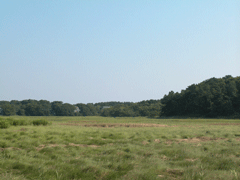
An area exhibiting dieback at the Hammonasset State Park wetland in Connecticut.(Photo: Wade Elmer)
AHEARN: Steve Smith is a plant ecologist for the Cape Cod National Seashore. He’s crouched down in the muck plucking at the dead stalks of what used to be green marsh grass.
SMITH: I mean this amazes me. Look at these plants just barely hanging on. There’s no soil left around their root mass. It’s just gone, all that is gone.
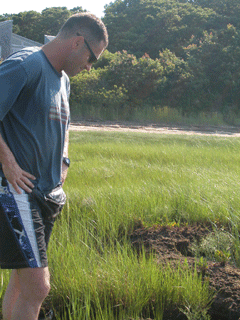
Steve Smith of the Cape Cod National Seashore surveys sick marsh. (Photo: Ashley Ahearn)
SMITH: That’s what’s perplexed us because this pattern of dieback does not correlate in any obvious way with the typical stressors on plant physiology and salt marsh plant vigor.
AHEARN: Stressors, like pollution, drought, flooding or ice damage, have been ruled out. But for every killer scientists cross off the list, another presents itself.
[HAMMONASSET MARSH – FOOTSTEPS IN MARSH]
AHEARN: In a wetland a state away, plant pathologist Wade Elmer of the Connecticut Agricultural Experiment Station, takes some samples of sick plants at Hammonasset State Park.
[SHOVEL IN MUCK, SLURPING AS SAMPLE COMES OUT]
ELMER: We’re the CSI of the plant world here.
[SHOVEL SOUND TO COVER LAUGHING]
AHEARN: Elmer specializes in a plant-eating family of fungus called Fusarium, which he thinks is causing lesions on the tips of the marshgrass.
ELMER: This is of interest to me because there’s a lot of death on there and if you look at how the sun shows through the leaf here you can see all the little lesions beginning to form there, and this is where I isolate a lot of Fusarium.
AHEARN: But this isn’t your day to day crop-devouring variety of the fungus. This is a brand new strain of Fusarium and Elmer’s got some good evidence that it might be part of what’s killing the Northeastern wetlands.
ELMER: What I find is that plants that are showing tip dieback, when I take them back to the lab and isolate them about 80% of the pieces that I put onto an auger plate will give rise to a Fusarium colony, suggesting that there’s a lot of Fusarium on this dying tip back.
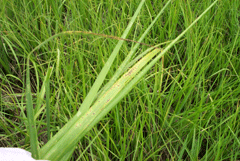
Wade Elmer suspects the fusarium fungus is eating away at marsh grass tips, causing the grass to turn yellow.(Photo: Wade Elmer)
AHEARN: Elmer’s colleague, Jim LaMondia, searches for clues in the marsh as well, but he’s working from the bottom up. In a metal pail, he rinses muck off a clod of marsh grass roots in search of nematodes.
LaMONDIA: A nematode is a plant parasitic round worm. They typically have stylettes that they stab the plant cells with and suck cell contents out and they cause the plants to be stunted and do poorly.
AHEARN: In the Hammonasset marsh, LaMondia has found a type of root-knot Nematode that only lives in wetlands. As he washes the mud away from the marsh grass sample, he looks for tiny white pustules, or galls, full of Nematode eggs.
LaMONDIA: There’s one right there! Ok what we have here is a sort of an egg shaped gall at the end of the root system which will have probably I’d guess maybe a dozen nematodes in it once we dissect this out under the microscope.
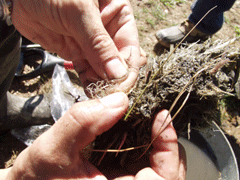
Jim La Mondia suspects nematodes are stunting growth of marsh grass roots. (Photo: Jim La Mondia)
LaMONDIA: Exactly, it’s a feeding site for them and they develop and produce hundreds of eggs each and it spreads from there.
AHEARN: LaMondia has found high concentrations of nematodes in these grasses. He suspects that the parasitic root-eating worms may be teaming up with Wade Elmer’s leaf-eating fungus, to kill the marsh grass from root to tip.
He and Elmer aren’t the only ones following up on their hunches. Another scientist in Rhode Island plans to study nocturnal crabs that might also see marsh grass as a tasty treat.
[MARSH SOUNDS]
Steve Smith, of the Cape Cod National Seashore, says scientists are just starting to piece together what little evidence they have to solve this intricate ecological puzzle.
SMITH: It’s this big complex web of interactions among environmental, physical, chemical, hydrological factors with biological and perhaps pathogenic factors that is difficult to untangle.
AHEARN: And with hurricane frequency and intensity predicted to increase in the Northeast, scientists here know there’s much to be lost if more isn’t learned about what’s causing sudden wetland dieback.
For Living on Earth, I’m Ashley Ahearn in Wellfleet, MA.
[MUSIC: Cinematic Orchestra “Familiar Ground” from ‘Ma Fleur’ (Nonesuch Records – 2006)]
Links
Living on Earth wants to hear from you!
Living on Earth
62 Calef Highway, Suite 212
Lee, NH 03861
Telephone: 617-287-4121
E-mail: comments@loe.org
Newsletter [Click here]
Donate to Living on Earth!
Living on Earth is an independent media program and relies entirely on contributions from listeners and institutions supporting public service. Please donate now to preserve an independent environmental voice.
NewsletterLiving on Earth offers a weekly delivery of the show's rundown to your mailbox. Sign up for our newsletter today!
 Sailors For The Sea: Be the change you want to sea.
Sailors For The Sea: Be the change you want to sea.
 The Grantham Foundation for the Protection of the Environment: Committed to protecting and improving the health of the global environment.
The Grantham Foundation for the Protection of the Environment: Committed to protecting and improving the health of the global environment.
 Contribute to Living on Earth and receive, as our gift to you, an archival print of one of Mark Seth Lender's extraordinary wildlife photographs. Follow the link to see Mark's current collection of photographs.
Contribute to Living on Earth and receive, as our gift to you, an archival print of one of Mark Seth Lender's extraordinary wildlife photographs. Follow the link to see Mark's current collection of photographs.
 Buy a signed copy of Mark Seth Lender's book Smeagull the Seagull & support Living on Earth
Buy a signed copy of Mark Seth Lender's book Smeagull the Seagull & support Living on Earth

